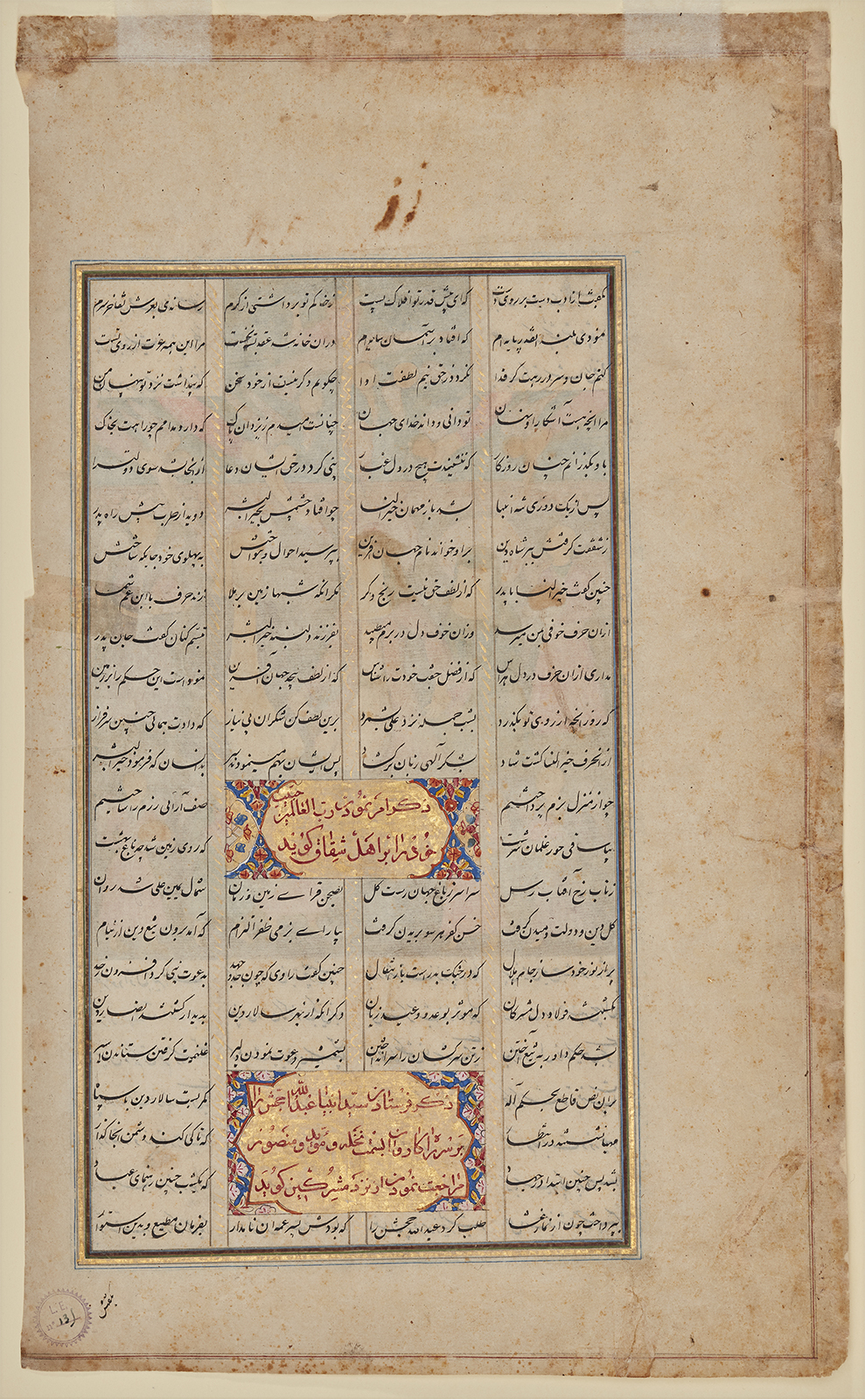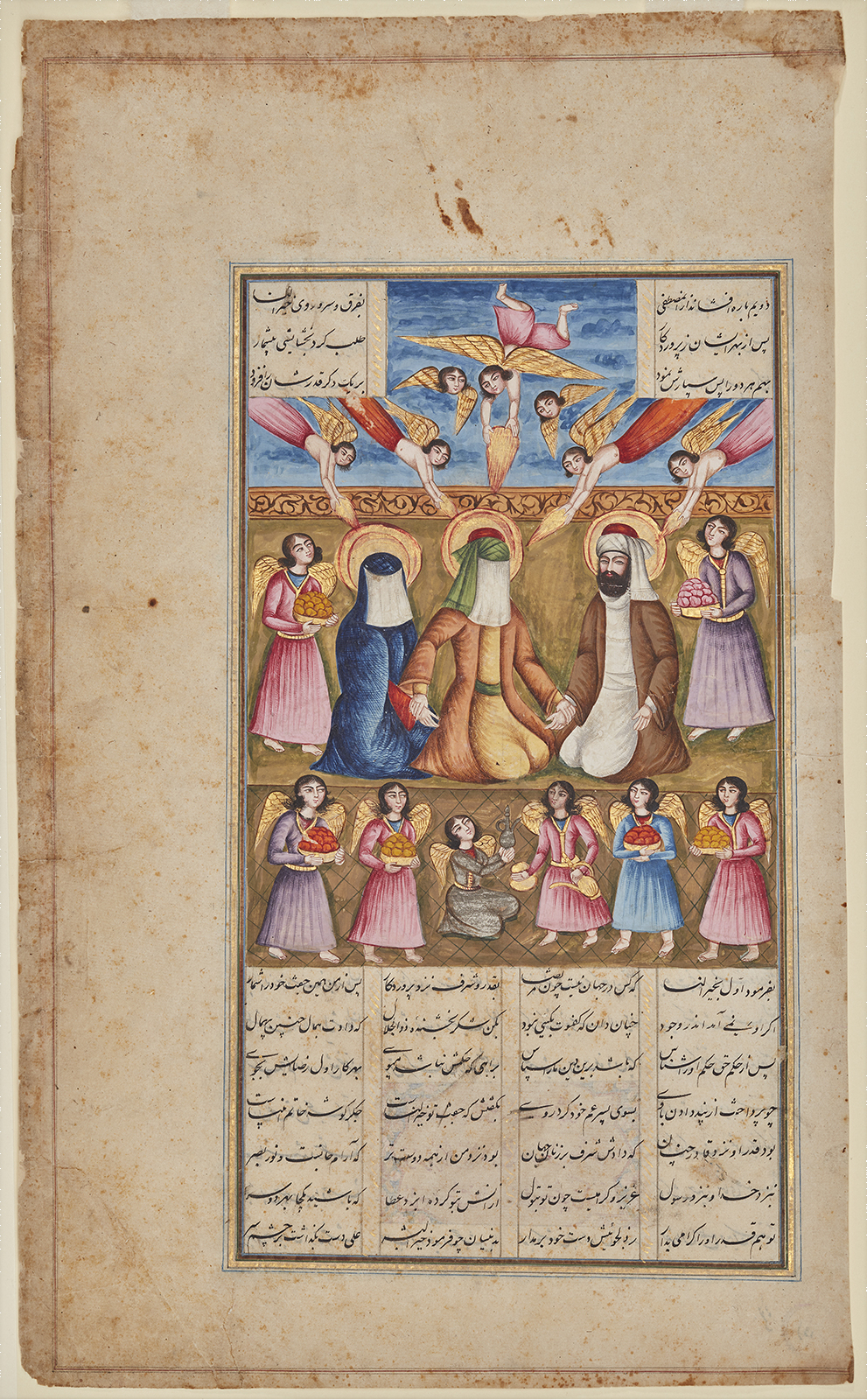Click on the image to zoom
The Marriage of 'Ali and FatimaThe Marriage of 'Ali and Fatima
- Accession Number:AKM116
- Place:Iran
- Dimensions:46.4 cm × 28.1 cm
- Date:ca. 1850
- Materials and Technique:Opaque watercolour, ink, and gold on paper
This painting is said to depict the marriage of ‘Ali and Fatima, cousin and daughter, respectively, of the Prophet Muhammad. It comes from an as-yet-unidentified text focusing on the life and achievements of ‘Ali, who was the fourth caliph to lead the Muslim community.[1] The text on the reverse describes some of the battles fought by him alongside the Prophet Muhammad
Further Reading
‘Ali, a cousin of the Prophet Muhammad, and Fatima, a daughter of the Prophet to whom ‘Ali was married, are among the most highly venerated of the Muslim figures, revered for their unwavering faith and role in spreading the belief to new devotees. They, along with their sons, Hasan and Husayn, are known as the ahl al-bayt, "the people of the house [of the Prophet]," and hold a particular place of distinction for Shi‘i Muslims, who believe that authority over the community properly descends among Muhammad’s heirs through ‘Ali.[2] This painting, with its image of Muhammad at the centre clasping the hands of ‘Ali, on his left, and Fatima, on his right, visually represents that strength of connection. All three figures are dressed modestly, and their heads are surrounded by haloes to indicate their holy status. In addition, Fatima and Muhammad’s faces are covered by veils. While the earliest surviving paintings portraying Muhammad in manuscripts from the 13th and 14th centuries do not typically shield a direct view of the Prophet, this convention became increasingly common after the early 16th century. It has been suggested that the veil enables a truly spiritual perception of the Prophet, undistracted by a visual form, to occur.[3] The trio is surrounded by angels bearing fruits and other offerings to celebrate the union.
- Marika Sardar
Notes
1. My thanks to Maryam Ekhtiar, who has been researching this manuscript, for confirming identification of the scene and mentioning additional folios from it in The Metropolitan Museum of Art (accession numbers 2019.318, 2019.319, 2019.320, 2019.321, and 1997.293).
2. A fuller explanation of their significance to the entire Muslim community can be read in Fahmida Suleman, ed., People of the Prophet’s House: Artistic and Ritual Expressions of Shi‘i Islam (London: Azimuth Editions, 2015), 13–16.
3. Christiane Gruber, "Between Logos (Kalima) and Light (Nur): Representation of the Prophet Muhammad in Islamic Painting," Muqarnas 26 (2009): 234–39, 248, and 254, note 5; and Christiane Gruber, "When Nubuvvat Encounters Valayat: Safavid Paintings of the Prophet Muhammad’s Mi‘raj, ca. 1500–1550," in The Art and Material Culture of Iranian Shi‘ism: Iconography and Religious Devotion in Shi‘i Islam, ed. Pedram Khosronejad (London: I.B. Tauris, 2010), 55–61 and 65.
References
Gruber, Christiane. "Between Logos (Kalima) and Light (Nur): Representation of the Prophet Muhammad in Islamic Painting." Muqarnas 26 (2009): 229–62. ISBN:9789004175891
When Nubuvvat Encounters Valayat: Safavid Paintings of the Prophet Muhammad’s Mi‘raj, ca. 1500–1550," in The Art and Material Culture of Iranian Shi‘ism: Iconography and Religious Devotion in Shi‘i Islam, ed. Pedram Khosronejad, 46-73. London: I.B. Tauris, 2010, reprinted 2014. ISBN:9781848851689
Suleman, Fahmida, ed. People of the Prophet’s House: Artistic and Ritual Expressions of Shi‘i Islam. London: Azimuth Editions, 2015. ISBN:9781898592327
Note: This online resource is reviewed and updated on an ongoing basis. We are committed to improving this information and will revise and update knowledge about this object as it becomes available.




